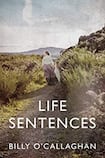
According to the OECD, it can take between two and 11 generations to rise out of poverty and attain the mean national income of your state. In Ireland it takes about five generations to leave behind the life-altering shocks of the poverty trap. And it’s been this way for quite some time, as Billy O’Callaghan’s novel Life Sentences ably illustrates.
Opening in 1920, we meet Jer Martin drinking to quench a murderous rage he’s nursing toward his brother-in-law Ned Spillane. Spillane has pushed Jer’s beloved sister Mamie into an untimely grave with his boozing and shiftlessness. Soon the RIC get wind of Jer’s drunken roaring and arrive to lock him a barracks cell for the night so as he can cool off ahead of Mamie’s funeral the following morning. The sergeant is Tom, with whom Jer fought alongside in the Munster Fusiliers at Flanders and Loos. For him, Jer goes quietly.
In the cell and later, on his walk home, Jer’s memories of his sister are all tied up with his own sense of shattered identity: his birth in the workhouse, the room corners where he was reared, his biological father who’s never publicly acknowledged him, his loss of religious faith on the battlefields of the Great War.
At dawn Jer returns to his loving wife and children and later counts his blessings when he looks across the grave at his brother-in-law and his nephews and niece. They’re now facing emigration to Lancashire and Nancy, Jer and Mamie’s mother, will go to live with them in Rochdale.
Backwards in time
In what has felt from the off like a family saga, Part II of Life Sentences surprises the reader when it becomes clear that rather than following Nancy to Rochdale, it’s taking a step backwards in time, to 1911, to allow Nancy narrate the story of her young womanhood. If Part I has been a hymn to familial love, then Part II examines the traps of desire.
In her teens Nancy leaves Clear Island to make a life on the mainland. Labouring on farms, it takes her three years to work her way to Cork city where, at 19, she enters service in the household of Mrs McKechnie, the dour Scottish wife of a lieutenant in the British army. Here she meets the jobbing gardener, Michael Egan, and though she’s not ignorant of the mechanics of sex, she’s certainly unworldly about romantic love and desire.
Egan, a consummate lady’s man, sweeps Nancy off her feet with his artful flirting and it’s only when she becomes pregnant that she hears Egan’s engaged and about to marry a Glanmire woman with whom he’s also had a child. Spurned by Egan, she is disgraced and jobless and gives birth to Mamie in the workhouse. Afterwards, to pay for one-quarter of a tenement room, Nancy uses the only commodity she owns – her body – to ply her trade in Cork’s nighttown.
Unsurprisingly, she runs into the now-married Egan and he gives her a pittance that allows her to leave the streets and sleep only with him. Still in thrall to him, Nancy becomes pregnant once more and again Egan turns his back on her. When Nancy re-emerges from the workhouse – now with two children to feed – she heads for Douglas and soon makes her way in the woollen mills there.
Much later, when Nancy has made a home and reared her children to adulthood, she still feels that Egan was the consistency that gave her life shape.
Personal history
Part III of Life Sentences is narrated in 1982 by Nellie, the youngest child of Jer. This sluggish section deals at length with the surreptitious midnight burial in 1940 of Nellie’s unbaptised baby conceived outside marriage. We discover in the acknowledgments that follow this closing section that the novel’s family history is based on the author’s own forebears.
Barring the many pages of bravura lyricism, O’Callaghan’s non-fiction novel is marred by its lack of coherence. Three lightly fictionalised narratives of family history do not a novel make; it is not enough to write them beautifully and set them side by side without any overarching narrative impetus or direction.
O’Callaghan makes clear that to be impoverished, in poor health and without social power is a life sentence that cannot be dodged, and that only cross-generational effort can affect a slow-moving upward trajectory. To the reader this message hits home early. The problem is that the quiet movements of ordinary lives, devoid of the incident and detailed weave of well-crafted fiction, provide little reason to turn the page.
Add to this, inconsistencies in tone, the improbable use throughout of “proper” English in the internal musings of working-class Cork characters, the great burden of exposition placed on flashbacks, and the overall impression is of a work that has failed to deliver on its ambitions.








